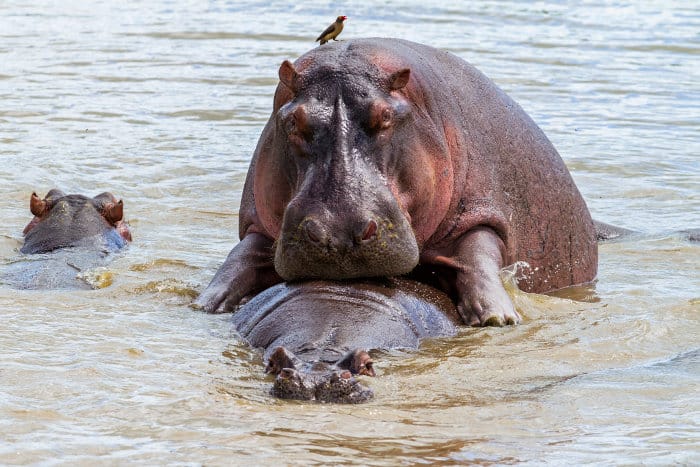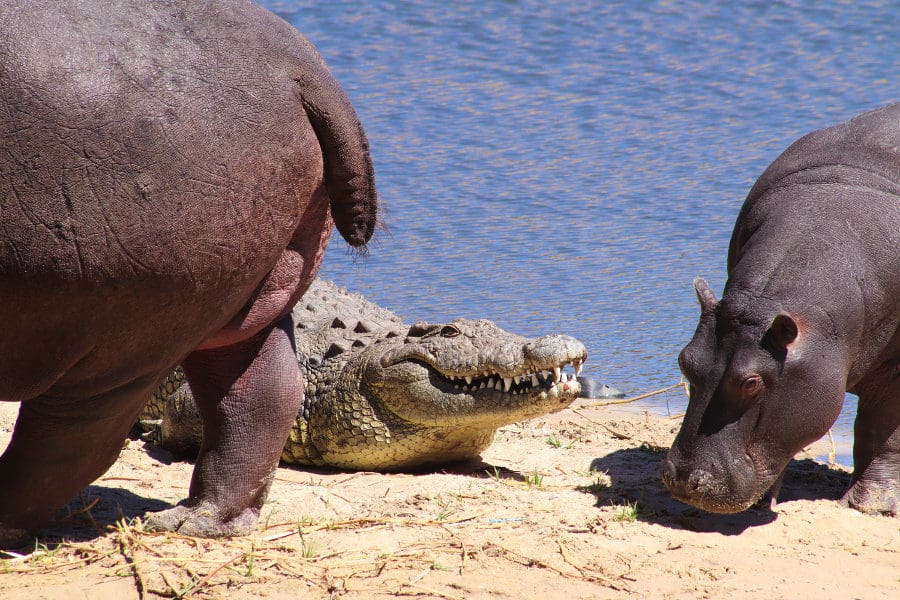These semi-aquatic animals are endlessly captivating and true oxymorons. Which is not to insult their intelligence. Yet they make up wonderful opposites.
Their bodies are balloon-shaped and comical, though their displays of aggression are truly scary. They weigh between 1300 – 4000 kg but can run faster than the average human, at 30 kilometers per hour. Even ‘hippo farts‘ are surprising.
Still, perhaps the strangest of their characteristics could be the color of hippo milk. Many believe that the color of hippo milk is pink. And it’s easy to see why you’d want to believe that. There are few things in life that could be sweeter than a chubby baby hippo feeding on his mother’s pink milk.
Unfortunately, it seems we’ll just have to keep imagining.
Is Hippo Milk Pink?

Hippo milk is sadly not pastel-colored. The rumor has been in the mill for a number of years. But it was really given legs in 2013 when National Geographic posted the following on Facebook – “Friday fact: A hippo’s milk is bright pink.”
Of course, coming from such a traditionally reliable source, the rumour really ran after that.
Hippopotamus milk is actually, like that of all mammals, an off-white color. Milky white, in fact.
So while it is possible for a mother hippo’s milk to turn pink under exactly the right conditions, the milk itself is not naturally pink. What conditions are these, you might ask? Well, we’ll answer these questions for you, yet it’s not recommended that you ever get close enough to check it out for yourself.
Coming that close would be a very unwise move. Hippos are, after all, the most dangerous animals in Africa.
How Does Hippo Milk Turn Pink?
While it doesn’t come out colored, there is a small chance of a hippo’s milk turning pink. This is because hippos secrete a natural sunscreen that has a reddish hue. And red and white, mixed, make pink.
The substance that they secrete is hipposudoric acid, which is often referred to as “blood sweat”. A harsh name for something that is neither of these things.
Due to its color and oily consistency, it might look like a hippo is sweating blood through its pores. Which would certainly increase their hardcore level.
Although hipposudoric acid is nothing of the sort. It’s actually a handy skin secretion specific to hippos, as the name suggests.
Hipposudoric acid acts as a natural sunscreen and microbial agent. It protects them from the harsh African sun and makes sure that bacteria don’t get a chance to breed on their backs. After all, they do spend a lot of time being warm and moist, which is prime bacterial growth conditions.
Yet most bacteria can only grow in neutral pH or low acidic environments. So this red acid is super helpful to the hippo, to keep their tough skin fresh and clean. Relatively at least.
If a mother’s milk mixes with the hipposudoric acid on her skin, it can turn from off-white, and make it look like pink hippo milk.
However, this is very unlikely, as baby hippopotami are generally hungry little things, and aren’t likely to let a drink go undrunk. The milk, therefore, doesn’t often have a chance to mix with the sunscreen secretion.
How Do Hippopotamus Calves Nurse?

Because hipposudoric acid is, of course, acid, it wouldn’t mix well with the milk. Milk has a below neutral pH value, and is therefore just a teeny bit acidic itself. So when the acid mixes with milk, it makes it curdle and go sour.
It is therefore a good thing that the calves don’t give it a chance to do so. When they’re hungry, they latch onto their mother’s teat so tightly that they are able to feed in any environment – land or water.
Hippos are semi-aquatic animals and are therefore well adapted to life in and out of the water. Baby hippos can fold their ears and close their nostrils, making it possible for them to feed underwater.
Newborn calves can only hold their breath underwater for about 40 seconds. But, while they take 42 months to reach maturity, it doesn’t take long until they are able to hold their breath for up to 5 minutes.
Being able to feed underwater is a handy skill when your mom rules the waters. There are very few predators that would risk attacking a baby hippo latched onto their mother.
An underwater feeding makes it much more unlikely that the milk will mix with the hipposudoric acid and turn pink. Also, it makes it completely impossible for us to observe the whole situation. Because no one is getting in the water with a mother hippo and her calf.
How Do Hippos Reproduce?

Hippos are polygamous animals, and often have multiple mates during their lives. Sadly, for the male hippo population, only around 10% of males ever get a chance to mate. This is because they must acquire territory and be the dominant male in their area.
Which is not an easy thing to do. Though if they have the skills, size, and good luck to pull it off, the reward is pretty sweet. Dominant males will generally have about 10 females (cows) in their territory.
Cows reach sexual maturity between 7 and 15 years of age, and males between 6 and 13 years. There is no linear pattern of maturation when it comes to hippos.
A hippopotamus can mate and reproduce throughout the year, but females’ peak season of fertility is between May and June. The male hippos know that females are fertile through smelling their urine. Which is certainly an interesting tactic.
The courting process is not pretty, with feces and urine being flung about by the male. They also throw some interesting grunts and wheezes into the mix.
When the male is successful, he will mount the female in the water. Fortunately, they are buoyant creatures, because their huge size and complete inability to jump would make mating on land quite the task.
Although even in the water, the male, who is often twice the size of a female, pushes the female down. It can be hard to catch a breath, and cows often have to fight to come up to the surface.
Yet in the end, the outcome is worth it. If their coupling is successful, a calf will be born 8 months later.
What is Hippo Family Life Like?

Before the birth, and for the first 10 to 40 days of their calves’ life, mother hippos isolate themselves with their babies. They’ll do this until their baby is strong enough to venture into the world. It also gives them a chance to imprint on their calf, without any other hippos confusing the situation.
They’re extremely aggressive before and after giving birth, and this is a time where it’s particularly wise for all animals to steer clear. They also aren’t eating during this time, so they’re extra sensitive.
Hippo mothers are affectionate and loving towards their young. They nuzzle and nurse their babies for 8 to 12 months (just not with pink milk). And because they only reproduce every second year, they have plenty of time to spend with their beloved baby.
Though some mothers continue to keep others at bay, they often enroll their young in nurseries. Here one or more adults guard them along with other calves. It’s a great place for them to socialize and engage in play fights.
While males will have multiple mates and subsequent babies, if they have any, they are pretty decent fathers. They are protective and keep Nile crocodiles at bay. These crocs are a baby hippo’s biggest threat, so the role of protector is an important one.
What Color Are Hippopotamuses?
Hippos are well adjusted to life within rivers and other bodies of water, as their skin is muddy-brown to greyish in color. They blend in nicely if you’re not looking for them. Unless their size is making them obvious, of course.
While mostly mud-colored, they do have lovely pink undertones. So whereas we don’t get to have pink milk in the world, we do have pink hippos. Or at least, pinkish. NB: That still doesn’t make them nearly as adorable as their cousin, the pygmy hippo.
And, since they are extremely territorial and get into regular fights over territory and other matters, teeth marks often affect their overall color and appearance. The long scars and gashes often reveal their pink undertones more or turn into off-white scar tissue.
These scars can often aid in their bid to look intimidating. And I’d vote that these bulbous, family loving creatures need it if they want a foot in the competition of being the scariest animal. It would certainly make a good fit, as they are already the most dangerous.
Hippo Pink Milk Myth Debunked

As lovely as it would have been to live in a world where tubby baby hippopotamuses feed on pink milk, we’ll have to settle for this one. A world where baby hippos get lots of love and care, until they become loving parents themselves. A pretty perfect depiction of the circle of life.
There are tons of questions floating around the internet, like ‘what color is hippo milk?’, and ‘why is hippo milk pink?’. Even if hippos don’t have this particularly cute characteristic, they have plenty more to make up for it.
If you’d like to experience these incredible creatures in their natural habitat, plan your ideal African safari here!



